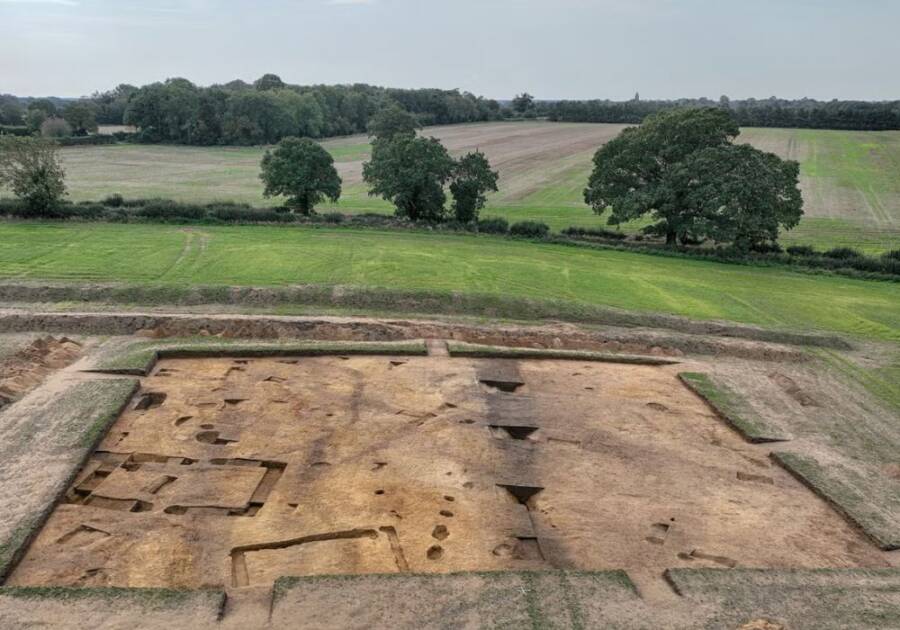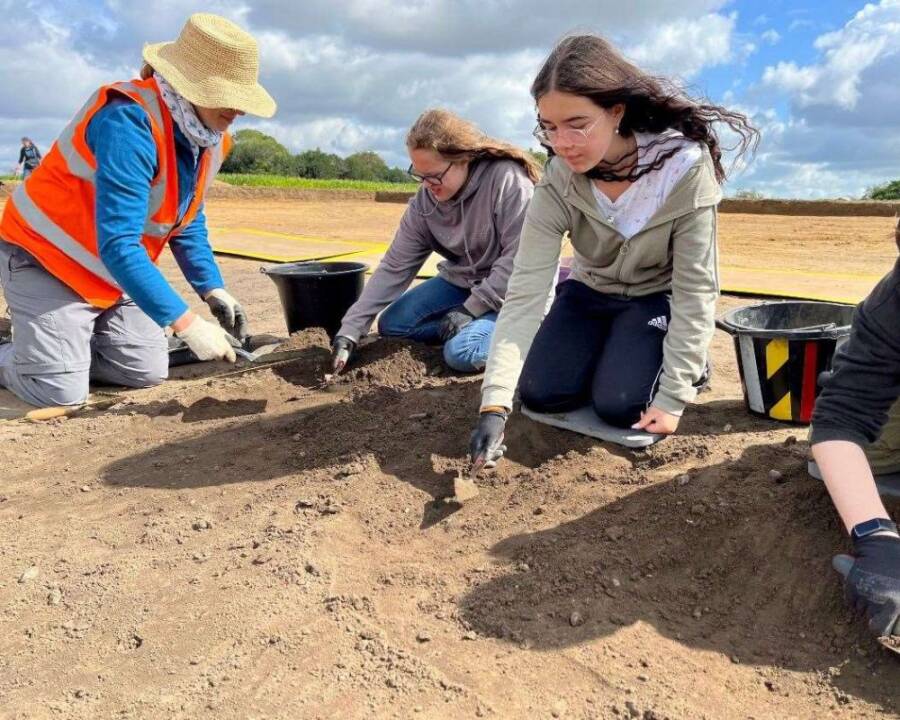The structure was unearthed at the site of a larger Anglo-Saxon settlement that archaeologists believe was a "center of royalty" around the 7th century C.E.

Suffolk County CouncilThe timber hall was found just four miles from the famed Sutton Hoo burial site.
Archaeologists in England have unearthed what they believe to be a pre-Christian pagan temple in a “rare and remarkable” discovery.
The 1,400-year-old structure was discovered in Rendlesham, a village in Suffolk, just four miles from the notable Sutton Hoo burial site. Indeed, experts believe there may even be a connection between the two locations.
Christopher Scull, an archaeologist and professor at Cardiff University and University College London who led the excavations, said the wooden building was likely “a pre-Christian temple or cult house from the period of the Kingdom of East Anglia, when Norfolk and Suffolk was a small independent kingdom of the Angles,” according to Ancient Origins.
The kingdom of East Anglia, which comprises the modern counties of Suffolk and Norfolk, was founded in the 6th century C.E. It is believed that King Redwald of East Anglia kept a temple for both Christian and pagan worship around the time the Rendlesham structure was built.
“It is most similar to buildings elsewhere in England that are seen as temples or cult houses, therefore it may have been used for pre-Christian worship by the early Kings of the East Angles,” Scull noted.
Last year, a large timber hall was discovered at the same site, leading to the belief that the area was once a royal settlement. Follow-up excavations at the site revealed the possible temple, which measured more than 32 feet long and 16 feet wide.
Scull said the building was “unusually high and robustly built for its size,” suggesting it was perhaps “constructed for a special purpose.”
In addition to the potential temple, archaeologists uncovered two other timber halls, a clay mold from the 7th century C.E. that was used to make decorative horse harnesses, two graves, and evidence of even earlier settlements as far back as the Neolithic period. The excavation was sponsored by Suffolk County Council’s “Rendlesham Revealed” community archaeology project.

Suffolk County CouncilArchaeologists have been excavating the Rendlesham site for three years and believe it may have been a settlement for Anglo-Saxon royals.
“This year’s findings round off three seasons of fieldwork which confirm the international significance of Rendlesham’s archaeology and its fundamental importance for our knowledge of early England,” said Councillor Melanie Vigo di Gallidoro, Suffolk County Council’s deputy cabinet member for protected landscapes and archaeology. “Everyone involved in the project can take pride that together we have achieved something remarkable.”
The Anglo-Saxons ruled most of modern-day England between the 6th and 11th centuries C.E. and brought their Germanic language and beliefs with them. They largely practiced polytheistic paganism until a broad conversion to Christianity began around the 8th century C.E.
The location of the find is notable, as it is just four miles from Sutton Hoo, which has been an important archaeological site since its discovery in 1939. Sutton Hoo features two royal Anglo-Saxon cemeteries and provided the first major insight into the Anglo-Saxon rule.
Most notably, Sutton Hoo is the site of “the most impressive medieval grave to be discovered in Europe,” according to the British Museum. A buried ship of nearly 90 feet in length was found at the site with a massive burial chamber full of riches. It is believed to be a funerary monument and the burial site of an East Anglian king — possibly Redwald himself — since ship burials were reserved for the highest members of society.
The temple found in Suffolk, along with its proximity to Sutton Hoo, is giving archaeologists and historians important insights into the ancient East Anglian kingdom and, more broadly, into Anglo-Saxon culture.
“The results of excavations at Rendlesham speak vividly of the power and wealth of the East Anglian kings and the sophistication of the society they ruled,” Scull said. “The possible temple, or cult house, provides rare and remarkable evidence for the practice at a royal site of the pre-Christian beliefs that underpinned early English society.”
After reading about the possible pagan temple found in Suffolk, learn about the entire ancient Roman town discovered off of an English highway. Or, discover how a massive 1,600-year-old pagan idol was found in an Irish bog.





